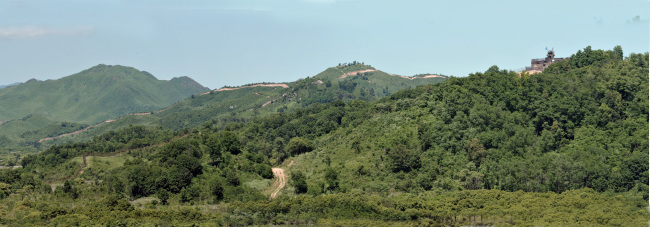Opinion divided over DMZ peace park
Ambitious plan faces mixed reactions as trust still elusive for Koreas
By Korea HeraldPublished : Sept. 1, 2013 - 21:07
With its serene landscape and undisrupted wildlife, the Demilitarized Zone between the two Koreas already looks like a peace park.
But beyond the horizons, Cold War tension is palpable. Fully armed soldiers stand guard, eyeing each other with machine guns and tucked-away hand grenades. The 4-kilometer-wide, 250-kilometer-long frontier zone is strewn with land mines, dotted by guard posts and surrounded by heavy artillery.
President Park Geun-hye is pushing to build a “peace park” in the DMZ as a new symbol of reconciliation and conservation.
But skeptics doubt its feasibility, citing the still-elusive political trust between the two Koreas and the unpredictable nature of their relations, which had frustrated any similar attempts by her predecessors.
The DMZ was set up as a buffer zone in the Korean War Armistice of July 1953 that ended the bloody fratricidal war. It is now the world’s most fortified border with 70 percent of the troops of both Koreas stationed near the areas.
But beyond the horizons, Cold War tension is palpable. Fully armed soldiers stand guard, eyeing each other with machine guns and tucked-away hand grenades. The 4-kilometer-wide, 250-kilometer-long frontier zone is strewn with land mines, dotted by guard posts and surrounded by heavy artillery.
President Park Geun-hye is pushing to build a “peace park” in the DMZ as a new symbol of reconciliation and conservation.
But skeptics doubt its feasibility, citing the still-elusive political trust between the two Koreas and the unpredictable nature of their relations, which had frustrated any similar attempts by her predecessors.
The DMZ was set up as a buffer zone in the Korean War Armistice of July 1953 that ended the bloody fratricidal war. It is now the world’s most fortified border with 70 percent of the troops of both Koreas stationed near the areas.

President Park floated the idea as part of her trust-building process during her address to the U.S. Congress in May.
She followed up on Aug. 15 with a formal proposal to the North during her Liberation Day speech.
“By making the Demilitarized Zone a symbol of peace, we can erase the memories of war and provocations, and create a new beginning of trust, cooperation and unity on the Korean Peninsula,” she said during her speech.
The potential peace park will encompass territories of both Koreas along with parts of the DMZ. Hundreds of landmines, military observation posts and heavy artillery will have to be cleared, which would be impossible without a high level of mutual confidence.
“Unfortunately, until a more fundamental political trust can be gained, I don’t think the DMZ peace park has a high possibility of working,” said Park Eun-jin, a research fellow at the think tank Gyeonggi Research Institute.
Daniel Pinkston, Northeast Asia deputy project director for the International Crisis Group, cautioned that the project will need much time and efforts from both sides.
“You have to look at how you are going to incentivize the peace park to the North. There are easier things like environmental protection, biodiversity and endangered species that both the South and North can look at.”
“But from a purely bipartisan, multilateral perspective, I think South Korean politicians must look at this peace park without emotion. This means studying and analyzing what President Roh (Moo-hyun) proposed at his meeting with Kim Jong-il in 2007 despite the scandal involving what Roh had said about the de facto maritime border in the West Sea,” said Pinkston.
In 2007, Roh consulted with then-North Korean head Kim Jong-il about building a peace enclosure inside the DMZ. Kim declined, however, citing security concerns.
“There are aspects that politicians studying the peace park can learn from in what Roh proposed. This is not a left-right issue.”
Liberal governments led by Kim Dae-jung and Roh had pushed to utilize the well-conserved site in the DMZ for peaceful ventures. CNN founder and conservationist Ted Turner also offered financial support for a peace park after visiting Pyongyang in 2005.
North Korea has consistently refused such propositions, accusing the South of attempting to “permanently divide the Korean Peninsula” and to have “disgraced the Korean people.”
Proponents, however, are hopeful that recently softened tensions between the two Koreas would pave the way for her plan.
Inter-Korean relations have looked up lately as both Koreas agreed to proceed with family reunions in September at Mount Geumgangsan while also signing a deal to end the four-month closure of the joint Gaeseong industrial complex.
Although the North has not responded to Park’s proposal, its United Front Department head Kim Yang-gon, who oversees South Korea policy affairs, told a South Korean businessman in July that the peace park plan would depend on how the two Koreas’ talks on Gaeseong would proceed. At that time, the two Koreas struggled to find common ground to end the suspension of the factory zone just north of the border.
The U.N. also expressed support for the plan recently. After meeting with Park in Seoul on Aug. 23, Secretary-General Ban Ki-moon, a former foreign minister of South Korea, told reporters that the international body would actively assist “if President Park made good consultations with the North and made progress.”
The Unification Ministry in charge of inter-Korean relations has formed a task force to push for the plan. On Friday, the government picked the project as a top priority in inter-ministry consultations.
The local governments of three potential locations in Gyeonggi and Gangwon provinces are engaging in a competition to host the envisioned peace installation.
Seoul officials have not announced specific plans but said they have plenty of references, as past governments extensively studied plans to turn the scenic areas into a pacifist monument, tourism attraction and ecological park.
Independent experts have recently broached ideas about how to set up a peace establishment.
GRI research fellow Park advocates a “transitional model” in which one side unilaterally builds a park, clearing landmines and installing basic conservatory facilities.
As negotiations between the two Koreas finalize specific agreements on how to manage the system, the complex is extended to the other side of the border. She acknowledges the difficulty involved but says this is the most “realistic” inter-Korean model.
“Areas of common interest include digging up Korean War casualties buried in the DMZ, excavating cultural artifacts, and river control to prevent floods at the Imjingang River,” she added.
The Imjingang River flows from the North through the DMZ into the South, and miscommunication between the two Koreas’ water management authorities have led to fatalities during the monsoon seasons.
Untouched by humans for the past six decades, the DMZ is a haven for wildlife, reportedly holding at least 2,153 species including five level-1 and 25 level-2 endangered animal species ― showing an unparalleled rich biodiversity.
Song Sok-rok, a security studies professor at Kyungdong University in Goseong, Gangwon Province, proposed a “green detente” in which “the two Koreas build up environmental cooperation through a DMZ peace park, which will serve to lay a foundation for their reunification and further ease tension in Asia.”
During a conference on Thursday, he said the government could benchmark the European Green Belt which connects 24 countries as a backbone of a pan-European ecological network running from the Russian-Norwegian border, through Central Europe and the Balkans to the Black Sea.
By Jeong Hunny (hj257@heraldcorp.com)
-
Articles by Korea Herald




![[Herald Interview] 'Amid aging population, Korea to invite more young professionals from overseas'](http://res.heraldm.com/phpwas/restmb_idxmake.php?idx=644&simg=/content/image/2024/04/24/20240424050844_0.jpg&u=20240424200058)












![[KH Explains] Korean shipbuilding stocks rally: Real growth or bubble?](http://res.heraldm.com/phpwas/restmb_idxmake.php?idx=652&simg=/content/image/2024/04/25/20240425050656_0.jpg&u=)

